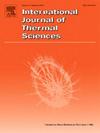Effect of multi-hole film interactions on thermal protection and drag reduction performances under supersonic condition
IF 4.9
2区 工程技术
Q1 ENGINEERING, MECHANICAL
International Journal of Thermal Sciences
Pub Date : 2025-06-26
DOI:10.1016/j.ijthermalsci.2025.110099
引用次数: 0
Abstract
Hydrocarbon-fueled scramjet engines face significant challenges related to aerodynamic frictional drag and thermal protection due to high-speed incoming flow and high-intensity combustion heat release. Multi-hole discrete film injection using gaseous hydrocarbon fuel can effectively reduce frictional drag while enhancing film cooling performance. Numerical simulations based on the Reynolds-Averaged Navier-Stokes method have been conducted to investigate the effect of multi-hole film interactions on thermal protection and drag reduction performances under supersonic condition in a supersonic combustor. The results indicate that multi-hole discrete film jets achieve better cooling efficiency and broader cooling coverage under supersonic incoming flow conditions compared with subsonic incoming flow at the same blowing ratio. Under subsonic condition, the small velocity difference between the multi-hole discrete film jets and the main flow exacerbates the penetration of the transverse jet into the main flow, leading to a decrease in cooling efficiency. Smaller lateral hole spacing (P/D) is better for combustion drag reduction and thermal protection performances under supersonic conditions, as it enables neighboring jets to form anti-kidney-type vortex pair structures and creates a cracking heat absorption region. Furthermore, the axial hole spacing (S/D) in aligned multi-hole discrete film jets significantly enhances thermal protection performance by regulating the chemical reaction of hydrocarbon fuel and extending the cracking reaction region. Secondary hydrocarbon-fueled film injection extends the cracking reaction region and delays the onset of the combustion heat release zone, thereby expanding the effective cooling region. Moreover, an optimization analysis of the cross multi-hole discrete film jet structure shows that cooling coverage increases to 73.5 % at S/D = 10 and P/D = 2, while the hydrocarbon fuel combustion resistance is reduced by 33.2 %.
多孔膜相互作用对超音速条件下热保护和减阻性能的影响
烃类燃料超燃冲压发动机由于高速来流和高强度燃烧热释放,在气动摩擦阻力和热防护方面面临重大挑战。采用气态烃类燃料的多孔离散喷油可以有效地减少摩擦阻力,同时提高气膜冷却性能。基于reynolds - average Navier-Stokes方法对超声速燃烧室中多孔膜相互作用对热防护和减阻性能的影响进行了数值模拟。结果表明,在相同吹气比下,与亚音速来流相比,多孔离散膜射流在超音速来流条件下具有更好的冷却效率和更大的冷却覆盖范围。在亚音速条件下,多孔离散膜射流与主流之间的速度差较小,加剧了横向射流对主流的渗透,导致冷却效率下降。越小的侧孔间距(P/D)越有利于超音速条件下的燃烧减阻和热防护性能,使相邻射流形成反肾型涡对结构,形成裂化吸热区。此外,定向多孔离散膜射流的轴向孔间距(S/D)通过调节烃类燃料的化学反应和扩大裂解反应区域,显著提高了热防护性能。二次烃燃料喷膜延长了裂解反应区域,延迟了燃烧放热区的开始,从而扩大了有效冷却区域。此外,对交叉多孔离散膜射流结构的优化分析表明,在S/D = 10和P/D = 2时,冷却覆盖率提高到73.5%,而碳氢燃料的燃烧阻力降低了33.2%。
本文章由计算机程序翻译,如有差异,请以英文原文为准。
求助全文
约1分钟内获得全文
求助全文
来源期刊

International Journal of Thermal Sciences
工程技术-工程:机械
CiteScore
8.10
自引率
11.10%
发文量
531
审稿时长
55 days
期刊介绍:
The International Journal of Thermal Sciences is a journal devoted to the publication of fundamental studies on the physics of transfer processes in general, with an emphasis on thermal aspects and also applied research on various processes, energy systems and the environment. Articles are published in English and French, and are subject to peer review.
The fundamental subjects considered within the scope of the journal are:
* Heat and relevant mass transfer at all scales (nano, micro and macro) and in all types of material (heterogeneous, composites, biological,...) and fluid flow
* Forced, natural or mixed convection in reactive or non-reactive media
* Single or multi–phase fluid flow with or without phase change
* Near–and far–field radiative heat transfer
* Combined modes of heat transfer in complex systems (for example, plasmas, biological, geological,...)
* Multiscale modelling
The applied research topics include:
* Heat exchangers, heat pipes, cooling processes
* Transport phenomena taking place in industrial processes (chemical, food and agricultural, metallurgical, space and aeronautical, automobile industries)
* Nano–and micro–technology for energy, space, biosystems and devices
* Heat transport analysis in advanced systems
* Impact of energy–related processes on environment, and emerging energy systems
The study of thermophysical properties of materials and fluids, thermal measurement techniques, inverse methods, and the developments of experimental methods are within the scope of the International Journal of Thermal Sciences which also covers the modelling, and numerical methods applied to thermal transfer.
 求助内容:
求助内容: 应助结果提醒方式:
应助结果提醒方式:


